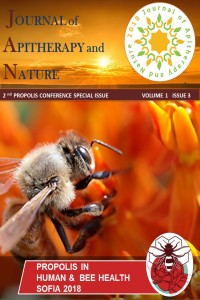Abstract
Propolis
has demonstrated a strong antioxidant activity1. This property,
together with other compositional parameters2 could contribute to
the difficult standardization of propolis. Antioxidant activity should be
determined by methods based on different mechanisms, and against several free
radicals3. The purpose of this research was to help characterize
propolis from Aragón (Spain) by determining the oxygen radical absorbance
capacity (ORAC)4, trolox equivalent antioxidant capacity (TEAC)5,
2,2-diphenyl-1-picrylhydrazyl (DPPH) assay6, as well as the
radical-scavenging effect on hydroxyl radicals (AOA)5 on
hydroalcoholic extracts of eight Aragonese propolis samples. Propolis extracts
were obtained with 70% (V/V) ethanol. All extracts showed high antioxidant
activities. The following averages were obtained: For ORAC 11070 µmol trolox/g,
for TEAC 1040.7 µmol trolox/g, for IC50 DPPH 0.0698 mg/ml and for
AOA 0.8783 mmol uric acid/g. At the 95.0% confidence level, significant linear
correlations were found between ORAC and TEAC (r= 0.9436), ORAC and AOA (r=
0.9142) and TEAC and AOA (r= 0.9919) and a double reciprocal correlation between
TEAC and DPPH (r= 0.7403). The lack of correlation between ORAC and AOA with
DPPH results is likely due to the fact that the antioxidant compounds of
Aragonese propolis could react very fast with both peroxyl (ORAC assay) and
hydroxyl (AOA assay) radicals, and at a slow pace to DPPH due to steric
inaccessibility3. Nevertheless, further studies are necessary to
corroborate this conclusion.
Acknowledgements: To all the beekeepers who have provided with a free
sample of propolis for this study.
Keywords
References
- 1. Daleprane JB, Abdalla DS (2013) Emerging Roles of Propolis: Antioxidant, Cardioprotective, and Antiantiogenic Actions. Evidence-Based Complementary and Alternative Medicine 2013: 1-8.
- 2. Bankova V. (2005) Chemical diversity of propolis and the problem of standardization. Journal of Ethnopharmacology 100: 114-117.
- 3. Prior RL, Wu X, Schaich K, (2005) Standardized Methods for the Determination of Antioxidant Capacity and Phenolics in Foods and Dietary Supplements. Journal of Agricultural and Food chemistry 53: 4290-4302.
- 4. Huang D, Ou B, Hampsch-Woodill M, Flanagan JA, Prior RL (2002) High-Throughput Assay of Oxygen Radical Absorbance Capacity (ORAC) Using a Multichannel Liquid Handling System Coupled with a Microplate Fluorescence Reader in 96-Well Format. Journal of Agricultural and Food chemistry 50: 4437–4444.
- 5. Osés SM, Pascual-Maté A, Fernández-Muiño MA, López-Díaz TM, Sancho MT (2016) Bioactive properties of honey with propolis. Food chemistry 196: 1215-1223.
- 6. Miguel MG, Nunes S, Dandlen SA, Cavaco AM, Antunes MD (2010) Phenols and antioxidant activity of hydro-alcoholic extracts of propolis from Algarve, South of Portugal. Food and Chemical Toxicology 48: 3418-3423
Abstract
References
- 1. Daleprane JB, Abdalla DS (2013) Emerging Roles of Propolis: Antioxidant, Cardioprotective, and Antiantiogenic Actions. Evidence-Based Complementary and Alternative Medicine 2013: 1-8.
- 2. Bankova V. (2005) Chemical diversity of propolis and the problem of standardization. Journal of Ethnopharmacology 100: 114-117.
- 3. Prior RL, Wu X, Schaich K, (2005) Standardized Methods for the Determination of Antioxidant Capacity and Phenolics in Foods and Dietary Supplements. Journal of Agricultural and Food chemistry 53: 4290-4302.
- 4. Huang D, Ou B, Hampsch-Woodill M, Flanagan JA, Prior RL (2002) High-Throughput Assay of Oxygen Radical Absorbance Capacity (ORAC) Using a Multichannel Liquid Handling System Coupled with a Microplate Fluorescence Reader in 96-Well Format. Journal of Agricultural and Food chemistry 50: 4437–4444.
- 5. Osés SM, Pascual-Maté A, Fernández-Muiño MA, López-Díaz TM, Sancho MT (2016) Bioactive properties of honey with propolis. Food chemistry 196: 1215-1223.
- 6. Miguel MG, Nunes S, Dandlen SA, Cavaco AM, Antunes MD (2010) Phenols and antioxidant activity of hydro-alcoholic extracts of propolis from Algarve, South of Portugal. Food and Chemical Toxicology 48: 3418-3423
Details
| Primary Language | English |
|---|---|
| Journal Section | 2nd Propolis Conference Special Issue |
| Authors | |
| Publication Date | December 8, 2018 |
| Published in Issue | Year 2018 Volume: 1 Issue: 3 - 2nd Propolis Conference Special Issue |
Cite
- Google Akademik (Google Scholar)
- idealonline
- Directory of Research Journal Indexing (DRJI)
- Asos İndeks


